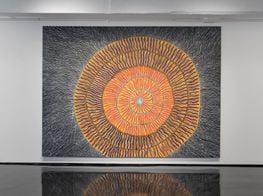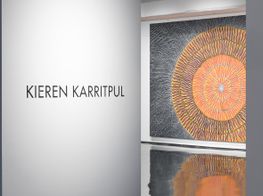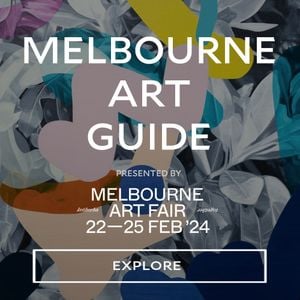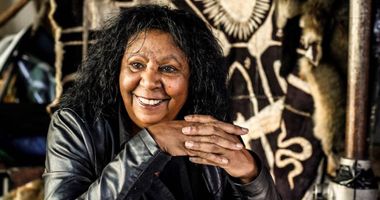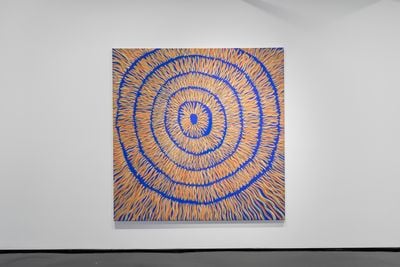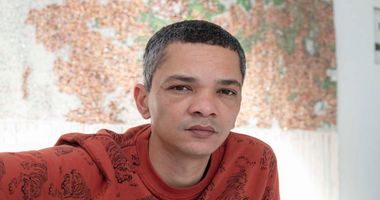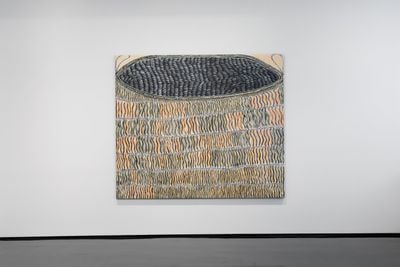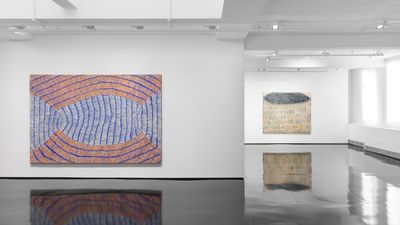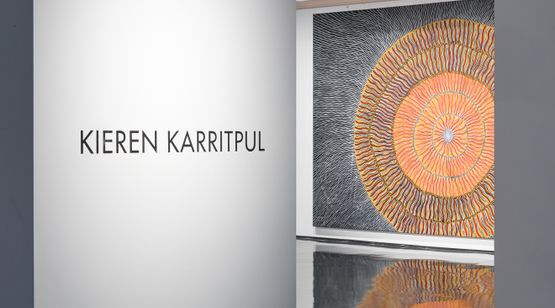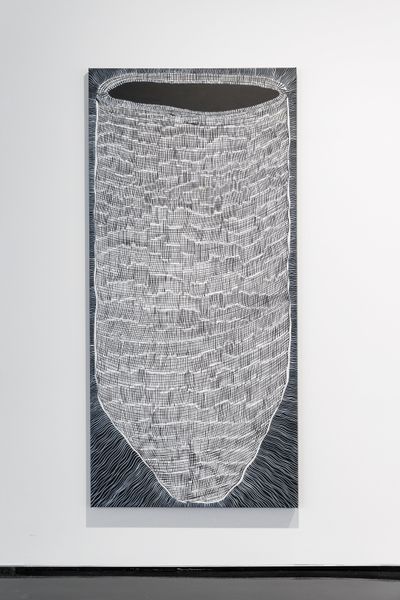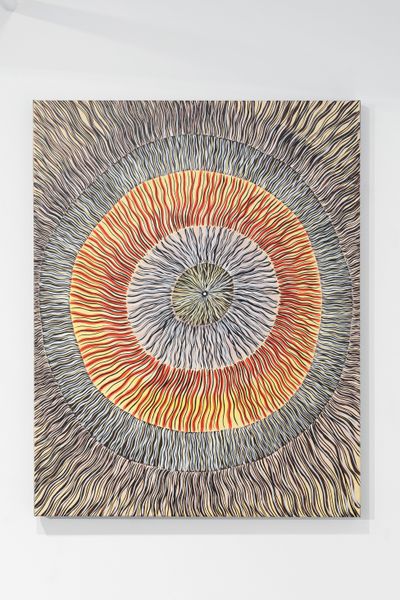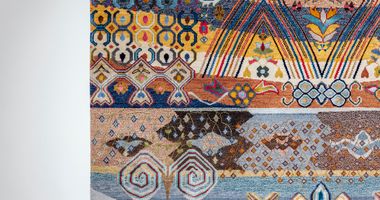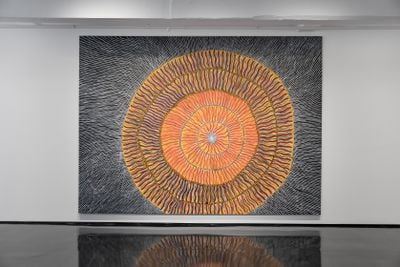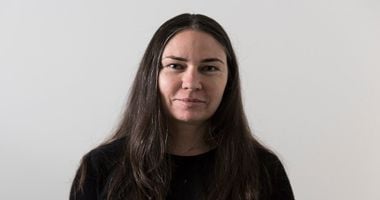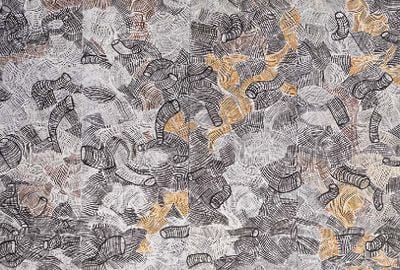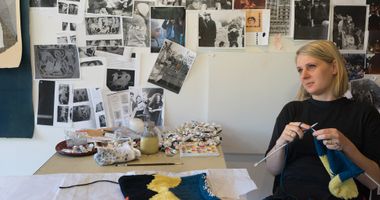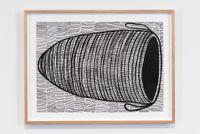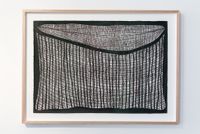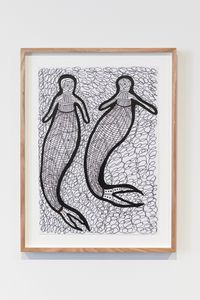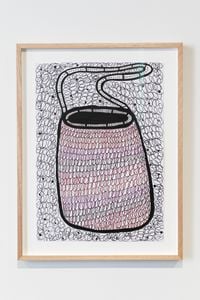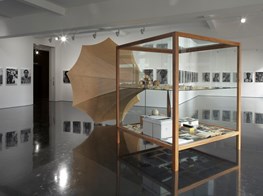Kieren Karritpul’s Portals to Nauiyu
Weaving is enmeshed in Kieren Karritpul's life—whether as a physical craft, metaphoric concept, or intergenerational custom. But the 28-year-old Ngen'giwumirri artist cannot practice the craft himself.
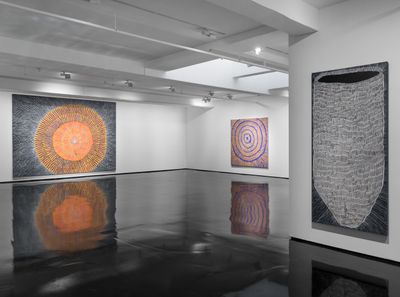
Exhibition view: Kieren Karritpul, Making the Ancestors Smile, Tolarno Galleries, Melbourne (29 October–19 November 2022). Courtesy Tolarno Galleries. Photo: Andrew Curtis.
Karritpul recalls playing with the fibres stripped by his mother, grandmother, and great-grandmother as a child, and of attempting to follow suit—but being reprimanded by his elders who would tell him that he was 'not allowed to weave because [he is] a male'.
In pursuit of developing his practice, Karritpul later asked permission from his grandmother and great-grandmother to make work about weaving, which they granted. He translated their fibre-based practice to canvas, paper, textile, and ceramics—in this way, carrying on the tradition of his ancestors, while shaping a singular aesthetic that harvests cues and gestures from the land.
Over the past few years, Karritpul has become known for paintings and designs that curiously zoom into woven objects, abstracting their criss-crossing structures into dilated, illusory portals that offer intimate pathways into the landscapes of Nauiyu, alien to most.
Ancestral pride is one of the main impetuses behind the continuity in Karritpul's familial language of weaving.
Nauiyu is a small settlement along the banks of the Daly River in Australia's Northern Territory. The area's traditional owners are the Malak-Malak people, who live both in Nauiyu and further upstream in Wooliana. The river is named after Dominick Daly, then-governor of South Australia, of which the Northern Territory had been a part. As with much of Australian land, Nauiyu holds a fraught colonial history.
Today, its population is only in the hundreds, predominantly Aboriginal, with around ten languages spoken in the region. These include the critically endangered Ngen'giwumirri, a Ngan'gi dialect. Karritpul and his mother, linguist and artist Patricia McTaggart Marrfurra, are two of the few speakers keeping the language warm.
Though small, Nauiyu is home to a thriving arts and cultural scene. Founded in 1986, the internationally recognised Merrepen Arts Centre is a hub for Indigenous artists to work and exhibit, with over 100 members, including Karritpul.
From aerial photographs, the Daly River landscape appears foreign. Its topographical palette features ochre riverbanks, lush green bush, arid earth, and glassy deep blue. The river is snake-like, with dramatic bends that arch towards one of the northernmost parts of Australia.
Karritpul's involvement in the arts flows deeper into the Indigenous Australian art community.
At 354-kilometres long, the river supports a diverse ecosystem—home to wildlife including crocodiles, turtles, and barramundi—an invaluable commodity and food source for the region. The barramundi is a migratory fish distributed across Australia's northern face, stretching from west to east. Typically growing over a metre long, the fish is favoured by the Daly's apex predators, saltwater crocodiles.
Barramundis are a popular target for anglers and recreational fishers and a big part of Australia's commercial fisheries. Adept at avoiding fixed nets, they are more likely to be caught using lines, traps, and lures. These tools form the primary subject of Kieren Karritpul's first major solo exhibition, Making the Ancestors Smile at Tolarno Galleries in Naarm (Melbourne) (29 October–19 November 2022).
Having grown up fishing around the river, Karritpul employs these objects to represent his intrinsic relationship with the land. He has said, 'We are the freshwater people. ... Our works are always based around the billabong, creek, rivers; bush tucker that we collect from the water. Water lilies from the billabong; animals like turtles, and fish ... The land is part of us, and we are part of the land.'
Karritpul's career, which spans painting, printmaking, textile design, and ceramics, has gained momentum in recent years. In 2019, he presented a duo exhibition at Cross Art Projects, Sydney, with his mother Patricia, titled Yerr Wetimbi yi Yerr Marrgu (Old Way & New Way).
In 2020, Karritpul was awarded Textile Artist of the Year at the inaugural National Indigenous Fashion Awards presented by the Darwin Aboriginal Art Fair Foundation, which led to a collaboration with Country Road Homewares in 2021.
Karritpul's involvement in the arts flows deeper into the Indigenous Australian art community. From 2018 to 2020, he was the youngest director at Association of Northern, Kimberley and Arnhem Aboriginal Artists (ANKA), the advocacy and support body for Aboriginal artists and art centres across northern Australia.
Making the Ancestors Smile comprises an arresting suite of large-scale paintings, drawings, and prints, which illustrate in abstract forms the fishnets, traps, and lures that are embedded within the daily lives of the Nauiyu people.
The largest painting on show, Big Fish Net Orange, Black and White (2022), centres on an abstract portal-like form, demarcated with concentric rings textured with gentle, rippling lines. The size of the canvas, just shy of three-by-four metres, immediately reduces viewers to the scale of a barramundi, perhaps, staring down a woven lure, unknowingly ensnared.
The perspectives from which these conical fish traps are depicted vary. In Many fish traps in the water (2022), the form becomes a loosely tessellating pattern, the traps themselves flattened. The red-ochre collagraph 2 Floating Fish Traps (2022) sees a more traditional rendering of the titular forms, with two elongated conical traps mirrored one above the other.
Pushed into their neighbouring contours, the lines composing Karritpul's paintings and drawings appear to pulsate subtly around their cores. Unlike the weavings of his elders—often made with fibres from sand palm, pandanus, and other Daly River bush plants—Karritpul's woven images are rendered in the permitted acrylic or texta pen, with infinitely repeated strokes and micro-adjustments of the hand or wrist.
Ancestral pride is one of the main impetuses behind the continuity in Karritpul's familial language of weaving, which recognises an ongoing relationship with the land, its people, and histories. As the artist states, 'the people that are seeing our works know that we are still here ... And we're still living in our own ways, and we're still telling our own stories.' —[O]

